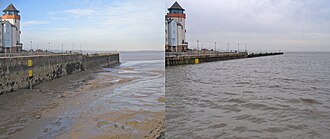
In oceanography, a tidal resonance occurs when the tide excites one of the resonant modes of the ocean.[1] The effect is most striking when a continental shelf is about a quarter wavelength wide. Then an incident tidal wave can be reinforced by reflections between the coast and the shelf edge, the result producing a much higher tidal range at the coast.
Famous examples of this effect are found in the Bay of Fundy, where the world's highest tides are reportedly found, and in the Bristol Channel. Less well known is Leaf Bay, part of Ungava Bay near the entrance of Hudson Strait (Canada), which has tides similar to those of the Bay of Fundy.[2] Other resonant regions with large tides include the Patagonian Shelf and on the continental shelf of northwest Australia.[3]
Most of the resonant regions are also responsible for large fractions of the total amount of tidal energy dissipated in the oceans. Satellite altimeter data shows that the M2 tide dissipates approximately 2.5 TW, of which 261 GW is lost in the Hudson Bay complex, 208 GW on the European Shelves (including the Bristol Channel), 158 GW on the North-west Australian Shelf, 149 GW in the Yellow Sea and 112 GW on the Patagonian Shelf.[4]
- ^ Platzman, G.W. (1991), "Tidal Evidence for Ocean Normal Modes", in Parker, B.P. (ed.), Tidal Hydrodynamics, New York: John Wiley & Sons, p. 883
- ^ O'Reilly, C.T.; Solvason, R.; Solomon, C. (2005). J. Ryan (ed.). "Where are the World's Largest Tides". BIO Annual Report: 2004 in Review. Biotechnol. Ind. Org., Washington, D. C.: 44–46.
- ^ Webb, D.J. (1976). "A Model of Continental-shelf Resonances". Deep-Sea Research. 23 (1): 1–15. Bibcode:1976DSRA...23....1W. doi:10.1016/0011-7471(76)90804-4.
- ^ Egbert, G.D.; Ray, R. (2001). "Estimates of M2 tidal dissipation from TOPEX/Poseidon altimeter data". Journal of Geophysical Research. 106 (C10) (C10): 22475–22502. Bibcode:2001JGR...10622475E. doi:10.1029/2000JC000699. S2CID 76652654.